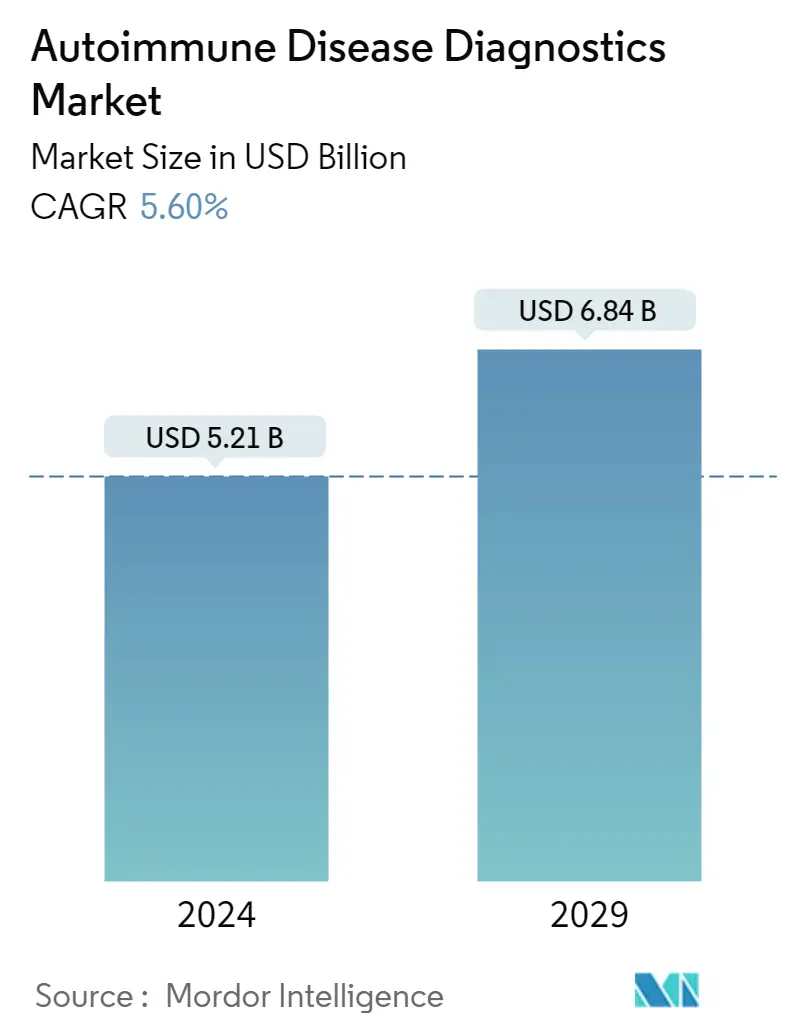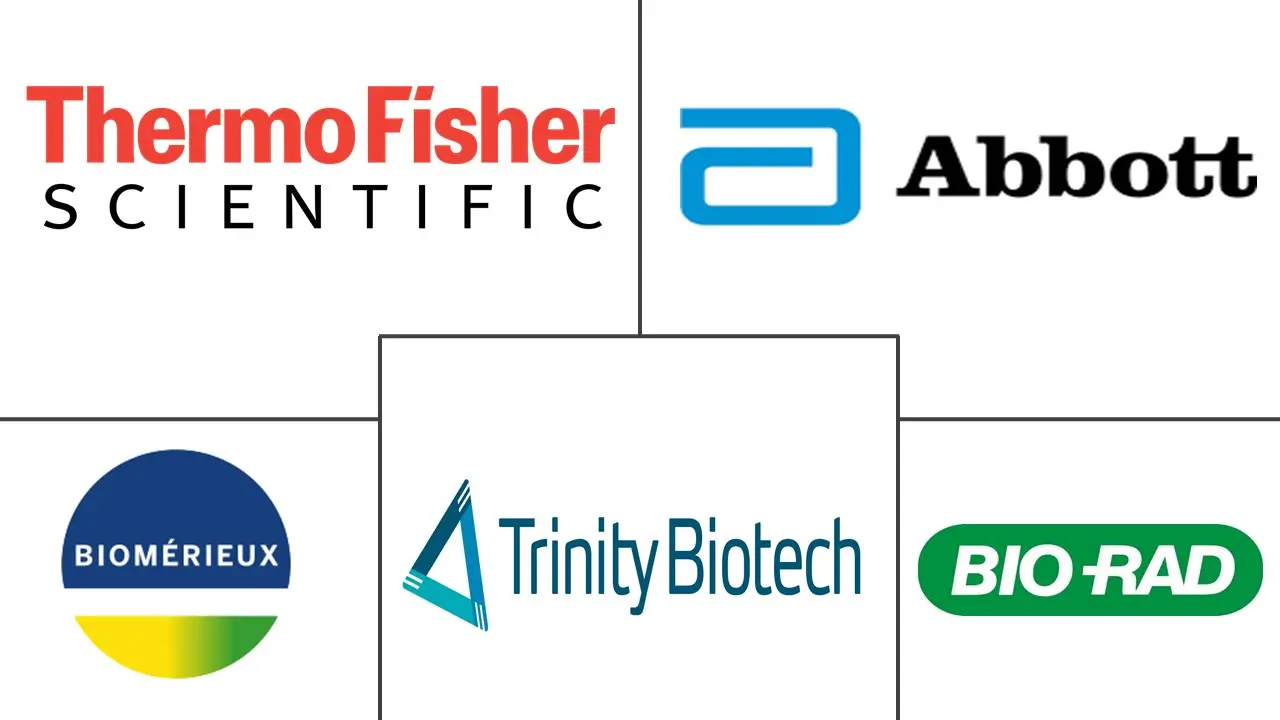Market Size of Autoimmune Disease Diagnostics Industry

| Study Period | 2024 - 2029 |
| Market Size (2024) | USD 5.21 Billion |
| Market Size (2029) | USD 6.84 Billion |
| CAGR (2024 - 2029) | 5.60 % |
| Fastest Growing Market | Asia Pacific |
| Largest Market | North America |
Major Players
*Disclaimer: Major Players sorted in no particular order |
Autoimmune Disease Diagnostics Market Analysis
The Autoimmune Disease Diagnostics Market size is estimated at USD 5.21 billion in 2024, and is expected to reach USD 6.84 billion by 2029, growing at a CAGR of 5.60% during the forecast period (2024-2029).
The first wave of the COVID-19 pandemic has disrupted almost all areas of healthcare services to some extent throughout the world. The negative impact of COVID-19 on patients with autoimmune disease diagnostics has also been recognized. According to an article published in October 2021 by Autoimmunity Reviews, a decrease in the number of autoantibody tests was observed in all European countries in the year 2020 compared to 2019. All autoantibody tests saw a 13% decrease, ranging from 1.4% in Switzerland to 25.5% in the United States (Greece). The decrease was most pronounced in all countries during the first wave of the pandemic (March-May 2020), with an overall decrease of 45.2% in those three months. The decrease was less pronounced (6.8%) in the second wave of the pandemic (October-December 2020). Thus, Covid-19 has a significant impact on the growth of the market.
The factors such as the growing burden of autoimmune disease and rising awareness about the diagnosis of disease coupled with technological advancement are propelling the growth of the market.
Increasing autoimmune disorders are expected to increase the autoimmune disease diagnostics market growth. More than 2.8 million people worldwide, including about 1 million in the United States, are currently living with multiple sclerosis, according to the Atlas of Multiple Sclerosis Report from 2020. Autoimmune illnesses are becoming more prevalent, which is a problem for European nations. The Multiple Sclerosis Trust estimates that there are 2.5 million people worldwide who have multiple sclerosis, with Europe having the highest prevalence in 2020. Women experience multiple sclerosis more frequently than males. Women experience multiple sclerosis more frequently than males. Rheumatoid arthritis affects two million people, while psoriasis, one of the most prevalent autoimmune disorders, is thought to impact between 2% and 3% of the general population. One major factor driving rising usage rates is the increased understanding of autoimmune disorders as a result of programs for research, education, support, and activism.
Moreover, the growing burden of autoimmune diseases in different parts of the world coupled with rising awareness about health and diseases creates the need for the diagnostics for early detection of diseases and thus drives the growth of the market. For instance, the American Autoimmune Related Disease Association (AARDA), which is committed to the eradication of autoimmune illnesses, the reduction of pain, and the socioeconomic impact of autoimmunity, designates the month of March each year as Autoimmune Disease Awareness Month (ADAM). The American Kidney Fund (AKF) launched a new patient-focused education and awareness campaign on lupus nephritis, a kidney condition caused by lupus, in February 2021. The AKF campaign gave lupus patients much-needed information they need regarding the symptoms, diagnosis, and treatment of lupus nephritis. The advertising for AKF was created using grant funding from GlaxoSmithKline plc. Similarly, in September 2021, Scipher Medicine entered a partnership with Ventegra Inc. The collaboration will allow Ventegra to provide its customers with access to Scipher's PrismRA liquid molecular signature test, which aids in determining the most targeted medicine for rheumatoid arthritis patients (RA). Thus, the abovementioned factors are expected to increase the market growth.
Thus, owing to the abovementioned factors, the market is expected to project growth over the forecast period. However, the slow turnaround time of results and need for multiple diagnostic tests, and high cost and reimbursement issues coupled with regulatory uncertainties may hamper the growth of the market.
Autoimmune Disease Diagnostics Industry Segmentation
As per the scope of the report, autoimmunity involves the loss of normal immune homeostasis, as the organism produces an abnormal response to its tissue. Autoimmune diseases generally affect the presence of self-reactive T cells, autoantibodies, and inflammation. Diagnosis of potential autoimmune disorders is challenging because not one laboratory test alone can produce the diagnosis results of the illness. The diagnosis can be helpful in the management of patients suffering from autoimmune diseases and help in providing a prognosis or indicating the severity of organ involvement or damage. The Autoimmune Disease Diagnostics Market is Segmented by Disease Type (Systemic Autoimmune Disease, and Localized Autoimmune Disease, Diagnosis Type (Antinuclear Antibody Tests, Autoantibody Tests, Complete Blood Count (CBC), C-reactive Protein (CRP), Urinalysis, and Others tests), and Geography (North America, Europe, Asia-Pacific, Middle East, and Africa, and South America). The market report also covers the estimated market sizes and trends for 17 different countries across major regions, globally. The report offers the value (USD million) for the above segments.
| By Disease Type | |||||||
| |||||||
|
| By Diagnosis | |
| Antinuclear Antibody Tests | |
| Autoantibody Tests | |
| Complete Blood Count (CBC) | |
| C-reactive Protein (CRP) | |
| Urinalysis | |
| Others tests |
| Geography | ||||||||
| ||||||||
| ||||||||
| ||||||||
| ||||||||
|
Autoimmune Disease Diagnostics Market Size Summary
The autoimmune disease diagnostics market is poised for significant growth over the forecast period, driven by an increasing prevalence of autoimmune disorders and heightened awareness of disease diagnosis. The market is experiencing a surge in demand due to the rising burden of autoimmune diseases globally, including conditions like multiple sclerosis, rheumatoid arthritis, and psoriasis. Technological advancements and strategic initiatives by key market players are further propelling market expansion. The impact of the COVID-19 pandemic, which initially disrupted diagnostic services, has been recognized, but the market is recovering as awareness and demand for early detection continue to rise. The aging population, particularly in regions like Asia-Pacific, is also contributing to market growth, as older individuals are more susceptible to autoimmune conditions.
The competitive landscape of the autoimmune disease diagnostics market is moderately active, with major players such as Abbott Laboratories, Biomérieux, and Thermo Fisher Scientific leading the charge. These companies are focusing on research and development, strategic partnerships, and product innovations to meet the growing demand for diagnostics. The introduction of new diagnostic tools and collaborations, such as those seen in Asia-Pacific, are expected to enhance market penetration and accessibility. Despite challenges like high costs and regulatory uncertainties, the market is set to expand, supported by ongoing efforts to improve healthcare infrastructure and increase awareness of autoimmune diseases.
Autoimmune Disease Diagnostics Market Size - Table of Contents
-
1. MARKET DYNAMICS
-
1.1 Market Overview
-
1.2 Market Drivers
-
1.2.1 Growing Burden of Autoimmune Diseases and Rising Public Awareness
-
1.2.2 Technological Advancements and Improved Laboratory Automation
-
-
1.3 Market Restraints
-
1.3.1 Slow Turnaround Time of Results and Need for Multiple Diagnostic Tests
-
1.3.2 High Cost and Reimbursement Issues Coupled with Regulatory Uncertainties
-
-
1.4 Porter's Five Forces Analysis
-
1.4.1 Threat of New Entrants
-
1.4.2 Bargaining Power of Buyers/Consumers
-
1.4.3 Bargaining Power of Suppliers
-
1.4.4 Threat of Substitute Products
-
1.4.5 Intensity of Competitive Rivalry
-
-
-
2. MARKET SEGMENTATION (Market Size by Value - USD million)
-
2.1 By Disease Type
-
2.1.1 Systemic Autoimmune Disease
-
2.1.1.1 Rheumatoid Arthritis
-
2.1.1.2 Psoriasis
-
2.1.1.3 Systemic Lupus Erythematosus (SLE)
-
2.1.1.4 Multiple Sclerosis
-
2.1.1.5 Other Systemic Autoimmune Diseases
-
-
2.1.2 Localized Autoimmune Disease
-
2.1.2.1 Inflammatory Bowel Disease
-
2.1.2.2 Type 1 Diabetes
-
2.1.2.3 Thyroid
-
2.1.2.4 Other Localized Autoimmune Diseases
-
-
-
2.2 By Diagnosis
-
2.2.1 Antinuclear Antibody Tests
-
2.2.2 Autoantibody Tests
-
2.2.3 Complete Blood Count (CBC)
-
2.2.4 C-reactive Protein (CRP)
-
2.2.5 Urinalysis
-
2.2.6 Others tests
-
-
2.3 Geography
-
2.3.1 North America
-
2.3.1.1 United States
-
2.3.1.2 Canada
-
2.3.1.3 Mexico
-
-
2.3.2 Europe
-
2.3.2.1 Germany
-
2.3.2.2 United Kingdom
-
2.3.2.3 France
-
2.3.2.4 Italy
-
2.3.2.5 Spain
-
2.3.2.6 Rest of Europe
-
-
2.3.3 Asia-Pacific
-
2.3.3.1 China
-
2.3.3.2 Japan
-
2.3.3.3 India
-
2.3.3.4 Australia
-
2.3.3.5 South Korea
-
2.3.3.6 Rest of Asia-Pacific
-
-
2.3.4 Middle East and Africa
-
2.3.4.1 GCC
-
2.3.4.2 South Africa
-
2.3.4.3 Rest of Middle East and Africa
-
-
2.3.5 South America
-
2.3.5.1 Brazil
-
2.3.5.2 Argentina
-
2.3.5.3 Rest of South America
-
-
-
Autoimmune Disease Diagnostics Market Size FAQs
How big is the Autoimmune Disease Diagnostics Market?
The Autoimmune Disease Diagnostics Market size is expected to reach USD 5.21 billion in 2024 and grow at a CAGR of 5.60% to reach USD 6.84 billion by 2029.
What is the current Autoimmune Disease Diagnostics Market size?
In 2024, the Autoimmune Disease Diagnostics Market size is expected to reach USD 5.21 billion.

